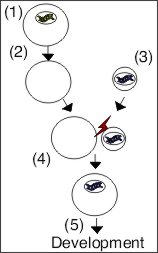Main page
Basic Concepts
Facts behind
the News
Genetic
Conditions
Links
Glossary
Feedback
Dolly, the clone
|facts behind news main page |geneinfo main page|
In February of 1997, Ian Wilmut and his colleagues in Scotland reported an amazing achievement: the production of an organism using the DNA from an adult cell. The result was 'Dolly,' a sheep with the exact same genetic material as an adult sheep, from which the DNA was taken; essentially, a twin delayed in time, an achievement which scientists were previously not certain was possible. The prospect of cloning mammals raised many concerns regarding the ethical implications of this technology. While this was indeed a new landmark in genetics, close examination of the facts reveals that, for both technological and legal reasons, cloning is still far from being applicable to humans. In addition, the significance of having identical genes has a notable but limited influence on the phenotype of an organism.
As discussed in the section on How to Evaluate Genetics News, it is important to see the original source of any news story: the journal article published by the researchers. The cloning of Dolly was reported in the journal Nature: Abstract:'Viable offspring derived from fetal and adult mammalian cells'
Cloning technology
Reproduction is usually the work of specialized cells in the ovaries of women and the testicles of men (for more information, see the section on How genes are inherited. Before the cloning of Dolly, it was thought possible that, as cells in the adult organs became specialized, the DNA might undergo subtle irreversible changes. Dolly demonstrated that the genetic material in other cells of the adult body contained all the information needed to produce a new organism.
 |
The technique used to clone Dolly is called nuclear transfer and is illustrated in the diagram to the left.
|
Scientific and medical research is a long and labor-intensive process. In order for a new development to be accepted, the result must be repeated multiple times under rigorously controlled conditions. While Dolly received all the media attention, it was not until the process of cloning from an adult mammalian cell was reproduced, in mice, that the technique was truly validated.
Even with the replication of the cloning process, the technique is still experimental and not yet optimized for general use. In the work leading to their published article, Wilmut and his colleagues made 277 attempts, with only one success. In the other cases, the cells died before implantation, or the developing animals suffered from developmental defects and did not survive to birth. A further technological hurdle to widespread cloning is the fact that embryos and embryonic development vary between species, and these differences will be obstacles in extending cloning technology to other mammals, such as humans.
topSignificance of cloning
Dolly and other animals cloned from adult cells allow researchers to address about genetics and development that were not possible before. In addition, the arrival of Dolly has opened the doors to a new world of possibilities. For example, most mammalian genetic research is currently conducted in mice, because their embryos are the easiest to manipulate. However, the findings in mice are not always applicable to humans, because of their biological differences. Sheep are biologically similar to humans, so the prospect of engineering sheep may lead the way to better animal models of human diseases, and other progress in research.
While there are still many technical obstacles to cloning a human, it is important to ask, and try to answer, questions about the possible applications of cloning and their consequences. In addition, there are numerous ethical and moral questions raised by the prospect of cloning which are too many and too complex to be discussed here.
- Will a clone be indentical to the adult "twin"?
- No. Because they have the same genes, the clone and adult whose DNA he or she shares will be similar, but the effects of prenatal and later environmental influences will shape each uniquely. The clone is likely to be less similar to the adult 'twin' than identical twins are to each other, because they would grow up in different conditions and and times, with different social and cultural atmospheres.
- What are some potential applications of cloning humans?
- Cloning may be used as an alternate way of having children, either by infertile couples, homosexual couples, single parents, parents wishing to have children who strongly resemble themselves or someone they know, or parents attempting to avoid known genetic defects. In theory, cloning could also be used to generate human embryos for research purposes, but the ethical objections to that applications would be considerable, so this is unlikely to happen.
- What are some barriers to human cloning?
- As discussed, there are numerous technical barriers to human cloning. In addition, many countries have legal restrictions on research involving human embryos. For example, in the United States, no federal funds can be used for human embryo research. Finally, given the high rate of embryo defects and deaths with this technique, any attempts to clone humans would be costly, as well as raise moral objections.
There are a lot of websites with information about Dolly and cloning. Some good sources of further information are:
- Hello Dolly! - A humorous and scientifically accurate look at cloning mammals
- Scientific American Magazine - Feature Article on Cloning
- New Scientist Magazine - Cloning Report
|facts behind news main page |geneinfo main page|
Note: Human genetics is an extremely complex topic. This website is meant only as an introduction and overview. If you are concerned about how genetics may affect your health, always consult your physician.
URL: http://geocities.datacellar.net/geneinfoPlease send feedback to geneinfo@yahoo.com
Latest revision: © January, 2000 by Julie S. Mak